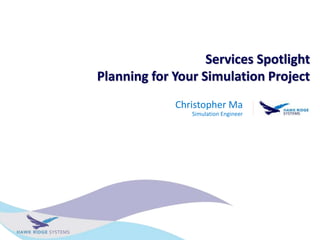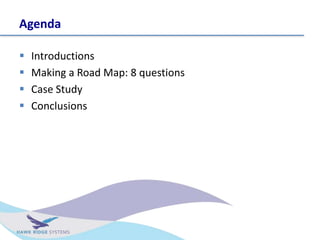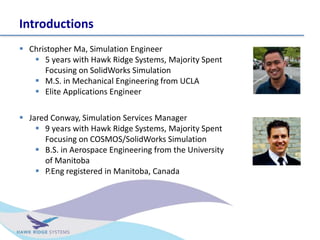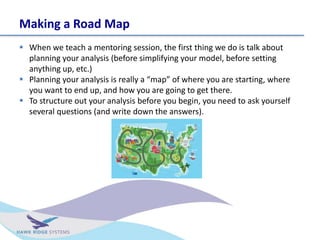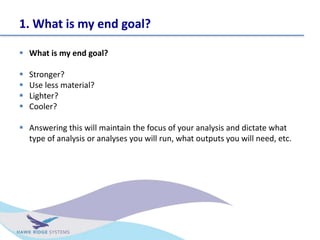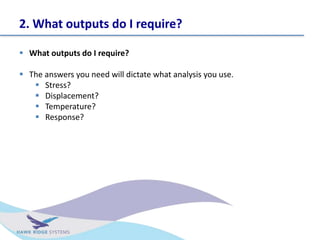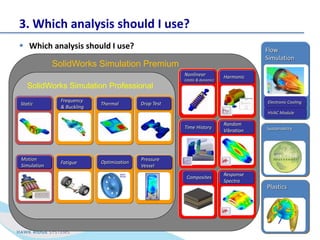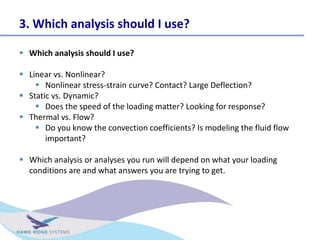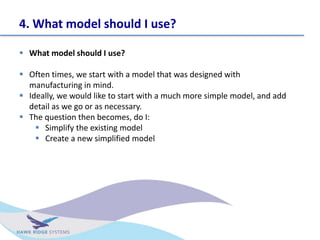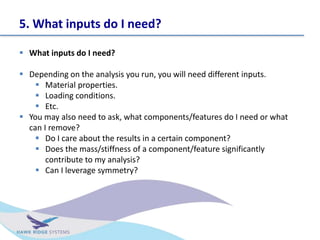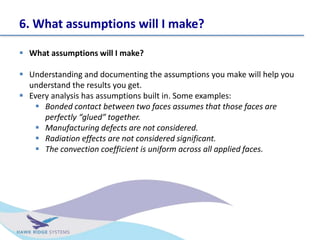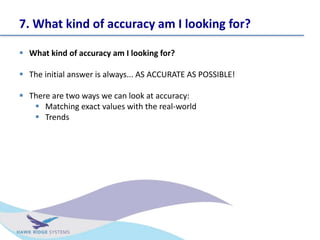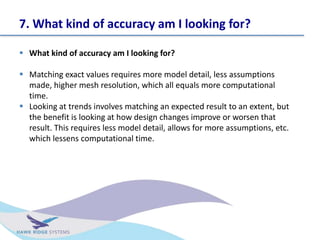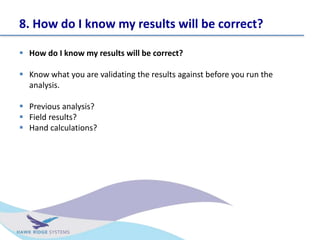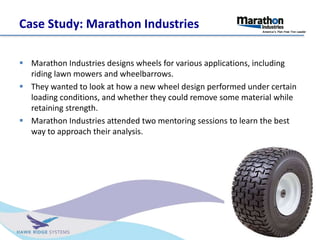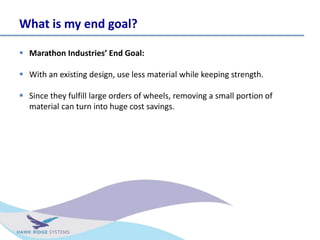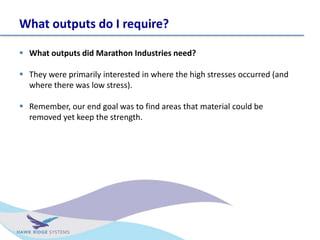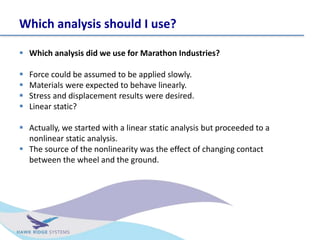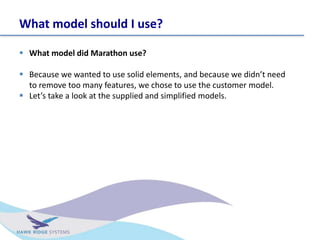Design Analysis - Planning for Your Next SOLIDWORKS Simulation Project
- 1. Services Spotlight Planning for Your Simulation Project Christopher Ma Simulation Engineer
- 2. Agenda ? Introductions ? Making a Road Map: 8 questions ? Case Study ? Conclusions
- 3. Introductions ? Christopher Ma, Simulation Engineer ? 5 years with Hawk Ridge Systems, Majority Spent Focusing on SolidWorks Simulation ? M.S. in Mechanical Engineering from UCLA ? Elite Applications Engineer ? Jared Conway, Simulation Services Manager ? 9 years with Hawk Ridge Systems, Majority Spent Focusing on COSMOS/SolidWorks Simulation ? B.S. in Aerospace Engineering from the University of Manitoba ? P.Eng registered in Manitoba, Canada
- 4. Making a Road Map ? When we teach a mentoring session, the first thing we do is talk about planning your analysis (before simplifying your model, before setting anything up, etc.) ? Planning your analysis is really a ˇ°mapˇ± of where you are starting, where you want to end up, and how you are going to get there. ? To structure out your analysis before you begin, you need to ask yourself several questions (and write down the answers).
- 5. 1. What is my end goal? ? What is my end goal? ? Stronger? ? Use less material? ? Lighter? ? Cooler? ? Answering this will maintain the focus of your analysis and dictate what type of analysis or analyses you will run, what outputs you will need, etc.
- 6. 2. What outputs do I require? ? What outputs do I require? ? The answers you need will dictate what analysis you use. ? Stress? ? Displacement? ? Temperature? ? Response?
- 7. 3. Which analysis should I use? ? Which analysis should I use? SolidWorks Simulation Premium SolidWorks Simulation Professional Static Frequency & Buckling Thermal Drop Test Fatigue Nonlinear (static & dynamic) Motion Simulation Optimization Pressure Vessel Harmonic Random Vibration Time History Composites Flow Simulation HVAC Module Electronic Cooling Response Spectra Sustainability Plastics
- 8. 3. Which analysis should I use? ? Which analysis should I use? ? Linear vs. Nonlinear? ? Nonlinear stress-strain curve? Contact? Large Deflection? ? Static vs. Dynamic? ? Does the speed of the loading matter? Looking for response? ? Thermal vs. Flow? ? Do you know the convection coefficients? Is modeling the fluid flow important? ? Which analysis or analyses you run will depend on what your loading conditions are and what answers you are trying to get.
- 9. 4. What model should I use? ? What model should I use? ? Often times, we start with a model that was designed with manufacturing in mind. ? Ideally, we would like to start with a much more simple model, and add detail as we go or as necessary. ? The question then becomes, do I: ? Simplify the existing model ? Create a new simplified model
- 10. 5. What inputs do I need? ? What inputs do I need? ? Depending on the analysis you run, you will need different inputs. ? Material properties. ? Loading conditions. ? Etc. ? You may also need to ask, what components/features do I need or what can I remove? ? Do I care about the results in a certain component? ? Does the mass/stiffness of a component/feature significantly contribute to my analysis? ? Can I leverage symmetry?
- 11. 6. What assumptions will I make? ? What assumptions will I make? ? Understanding and documenting the assumptions you make will help you understand the results you get. ? Every analysis has assumptions built in. Some examples: ? Bonded contact between two faces assumes that those faces are perfectly ˇ°gluedˇ± together. ? Manufacturing defects are not considered. ? Radiation effects are not considered significant. ? The convection coefficient is uniform across all applied faces.
- 12. 7. What kind of accuracy am I looking for? ? What kind of accuracy am I looking for? ? The initial answer is always... AS ACCURATE AS POSSIBLE! ? There are two ways we can look at accuracy: ? Matching exact values with the real-world ? Trends
- 13. 7. What kind of accuracy am I looking for? ? What kind of accuracy am I looking for? ? Matching exact values requires more model detail, less assumptions made, higher mesh resolution, which all equals more computational time. ? Looking at trends involves matching an expected result to an extent, but the benefit is looking at how design changes improve or worsen that result. This requires less model detail, allows for more assumptions, etc. which lessens computational time.
- 14. 8. How do I know my results will be correct? ? How do I know my results will be correct? ? Know what you are validating the results against before you run the analysis. ? Previous analysis? ? Field results? ? Hand calculations?
- 15. Case Study: Marathon Industries ? Marathon Industries designs wheels for various applications, including riding lawn mowers and wheelbarrows. ? They wanted to look at how a new wheel design performed under certain loading conditions, and whether they could remove some material while retaining strength. ? Marathon Industries attended two mentoring sessions to learn the best way to approach their analysis.
- 16. What is my end goal? ? Marathon IndustriesˇŻ End Goal: ? With an existing design, use less material while keeping strength. ? Since they fulfill large orders of wheels, removing a small portion of material can turn into huge cost savings.
- 17. What outputs do I require? ? What outputs did Marathon Industries need? ? They were primarily interested in where the high stresses occurred (and where there was low stress). ? Remember, our end goal was to find areas that material could be removed yet keep the strength.
- 18. Which analysis should I use? ? Which analysis did we use for Marathon Industries? ? Force could be assumed to be applied slowly. ? Materials were expected to behave linearly. ? Stress and displacement results were desired. ? Linear static? ? Actually, we started with a linear static analysis but proceeded to a nonlinear static analysis. ? The source of the nonlinearity was the effect of changing contact between the wheel and the ground.
- 19. What model should I use? ? What model did Marathon use? ? Because we wanted to use solid elements, and because we didnˇŻt need to remove too many features, we chose to use the customer model. ? LetˇŻs take a look at the supplied and simplified models.
- 20. What inputs do I need? ? What inputs did we need? ? They wanted to know what happens when a 200 lb load is applied to the wheel, and the wheel is sitting on the ground. ? The wheel is the primary concern. ? The wheel is attached to the axle by a bearing, and there is a tire on the wheel. ? We translated this real world setup into fixtures, connectors, and loading conditions. ? We used a bearing load to represent the force at the axle location. ? We used a rigid surface to represent the ground. ? We used half symmetry about the Right plane.
- 21. What assumptions will I make? ? What are some of the assumptions we made? ? Wheel experienced small deflections. ? Wheel material behaved linear elastically. ? Inertial effects were not significant (loads were applied slowly). ? The ground is much more rigid than the wheel and can be represented as a perfectly rigid surface. ? Effect of gravity is not considered significant.
- 22. What kind of accuracy am I looking for? ? What kind of accuracy did we need? ? For this analysis, we were closer to looking at trends. ? We wanted to get a close answer, but the real goal was to see how design changes affected the baseline.
- 23. How do I know my results will be correct? ? How were we going to validate our analysis? ? Marathon Industries had similar wheels already in the field, so they had a ballpark idea of the high stress areas and expected displacement. ? Marathon Industries was in the process of prototyping their new wheel design and testing it in the lab.
- 24. Conclusion ? Planning your analysis beforehand is crucial to running successful analyses consistently and finishing your project on time. ? Answering these 8 questions will help define your analysis project before you get started. ? DonˇŻt just ask the questions, keep a record of your answers to keep you on track and focused during the analysis process.
- 25. Hawk Ridge Systems Analysis Consulting Get in touch with Christopher: email: chrism@hawkridgesys.com phone: 650.230.7019 New & Existing Recorded Webinars: http://www.hawkridgesys.com/events /recorded-webinars/ Thank you for attending! Hawk Ridge Systems - At a Glance ? Serving over 25,500 customers in North America ? Largest SolidWorks Reseller Worldwide ? 16 Training Centers in North America ? Rated #1 in Service and Support by our users ? Phone US 877.266.4469 Canada 866.587.6803 ? Email info@hawkridgesys.com ? Web www.hawkridgesys.com

